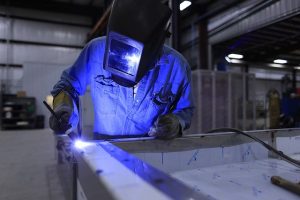
To protect against rust and corrosion, workpieces are often coated in a protective material. Thermal spraying, for instance, is a group of processes that involves the application of heated or melted material onto the surface of a workpiece. Once covered in the protective material, the underlying workpiece is protected from rust, corrosion and even physical damage. Plasma spraying, however, is a unique thermal spraying process that offers several noteworthy benefits. To learn more about plasma spraying and how it works, keep reading.
What Is Plasma Spraying?
Not to be confused with plasma welding, plasma spraying is a coating process that involves heating or melting material over the surface of a workpiece via a plasma jet. The material, which is usually either a liquid or powder, is projected into the plasma jet. As the material heats up temperatures in excess of 17,000 degrees Fahrenheit, it melts onto the surface of the workpiece.
The molten material, of course, quickly solidifies after landing on the workpiece. The liquid or powder particles essentially fuse together, resulting in the formation of a waterproof “shell” over the workpiece.
Benefits of Plasma Spraying
Plasma spraying offers several benefits, one of which is a high level of protection against rust and corrosion. Not all workpieces are vulnerable to rust and corrosion. Rather, it’s typically metal workpieces — especially those that contain iron — that are most susceptible to this phenomenon. When a metal workpiece is exposed to moisture, it may undergo a chemical reaction known as oxidation that manifests as rust and corrosion. Plasma spraying is a simple and effective way to protect workpieces from this phenomenon. Once sprayed with the liquid or powder particles, the workpiece will feature a protective shell that discourages rust and corrosion.
Plasma spraying also supports a variety of different coating materials. As previously mentioned, it can be used with either liquid or powder. With that said, there are many different types of liquids and powders that are supported by plasma spraying, each of which has different properties when melted and fused together.
In Conclusion
Plasma spraying is a thermal spraying process in which a workpiece is coated with a melted material. It involves the use of a plasma jet that melts the material as it’s deposited onto the respective workpiece. The plasma jet heats up the material so that it fuses together onto the surface of the workpiece. Once fused, the material forms a protective shell.
